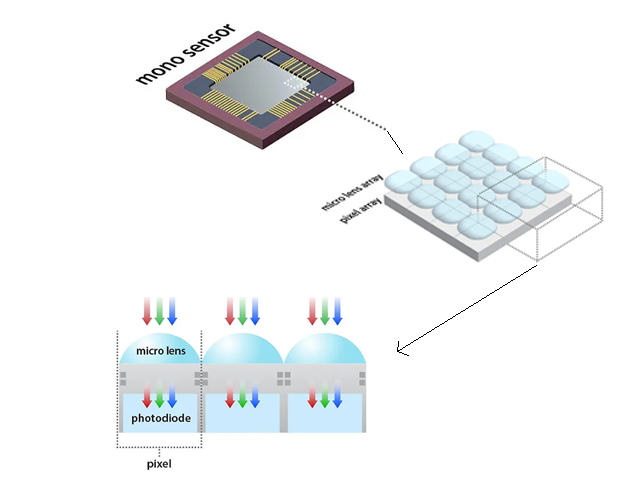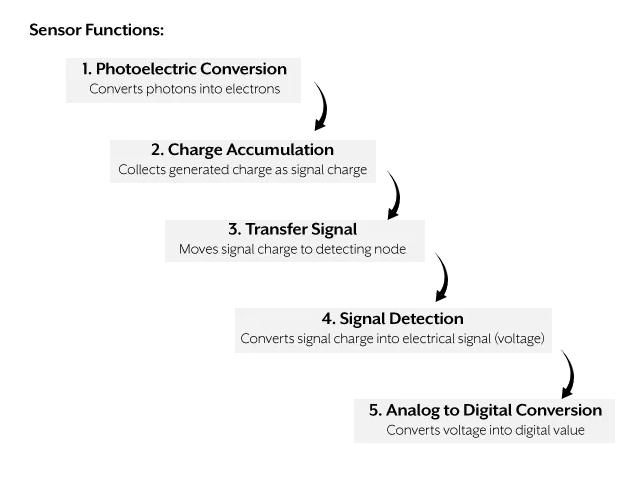How CMOS Sensors Work: A Beginner's Guide
CMOS (Complementary Metal-Oxide Semiconductor) sensors are the predominant image sensor technology used in most digital cameras today, from phones to DSLRs.

CMOS Component
Photodiode Array
A photodiode array is the main element in the along the lines with a CMOS sensor. Every single such pixel contains a photodetector, which is a semiconductor device that produces an electric current when the incident radiation is converted to the electric power. Light is converted into an electric charge by a photodiode in a way that the magnitude of the electric charge is applied to the intensity of the light.
Role of Transistors
The surrounding of each pixel in a CMOS sensor is made up of transitors aside from photodiode. Transistors are the electronic devices that receive weak electrical signal and amplify the signal and transfer the signal from one region to another. These circuits,encode the analog current,which is a result of the photo diode receiving,on which they perform.
Readout Process
It is then that the photodiodes (sensors) track the light and convert it into electromagnetic charges. The next phase is reading. The circuits with transistors for each pixel receive the electric charges that they boost and forward them to a circuit which finally converts them into a digital signal that comes out of the processor. The subsequent digital signal is usually processed by the camera's image processor, which harmonizes the image.
Here's a basic overview of how they work:
- A CMOS sensor contains an array of photosites, with each photosite made of a light-sensitive photodiode and access transistor.
- When light hits the photodiode, it generates charge proportional to the light intensity. This builds up voltage which represents the brightness value.
- The transistors are used to "read out" the voltage values pixel by pixel and convert them to digital data.
- On-chip analog-to-digital converters (ADC) change the pixel voltages into numbers that can be processed as a digital image.
- CMOS image sensors have the sensing, digitizing and other functions done directly on the sensor itself, unlike CCD chips.
- This allows CMOS sensors to access specific pixels for tasks like video recording while keeping others inactive to save power.

In essence, CMOS sensors convert photons of light into electric voltage values that can be digitized and processed as a digital photograph. This technology is widespread due to its high performance, low power usage, and semiconductor manufacturing compatibility.
FAQs:
Q: What's the difference between a CMOS and CCD sensor?
A: CCD sensors require off-chip processing while CMOS integrate it on-chip, allowing for better performances like lower power usage and more on-sensor functions in CMOS sensors.
Conclusion
Understanding the basic photoelectric and digital conversion process inside a CMOS sensor provides insights into why they are the most ubiquitous image sensor technology powering digital cameras today. Their on-chip design enables key advantages over CCDs that made them a popular choice.

 EN
EN
 AR
AR
 DA
DA
 NL
NL
 FI
FI
 FR
FR
 DE
DE
 EL
EL
 HI
HI
 IT
IT
 JA
JA
 KO
KO
 NO
NO
 PL
PL
 PT
PT
 RO
RO
 RU
RU
 ES
ES
 SV
SV
 TL
TL
 IW
IW
 ID
ID
 SR
SR
 VI
VI
 HU
HU
 TH
TH
 TR
TR
 FA
FA
 MS
MS
 IS
IS
 AZ
AZ
 UR
UR
 BN
BN
 HA
HA
 LO
LO
 MR
MR
 MN
MN
 PA
PA
 MY
MY
 SD
SD














